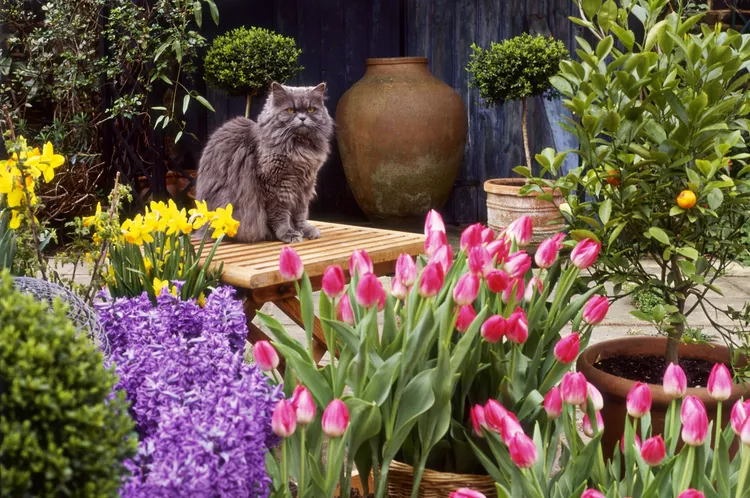Common Garden Plants That Are Toxic to Cats

A number of common garden plants are actually toxic to cats. it's important to be safe and know which plants are potentially harmful and by what degree. Some may cause kitty just a little discomfort, and other plants can be lethal.
The plants outlined are some of the more popular plants that can harm your cat. This is not an exhaustive list and you'll also want to refer to the ASPCA's toxic plants list to ensure your pets stay safe in the garden as well as with any houseplants inside the home.
If you believe your cat has eaten any of these even if it is not showing signs of being sick, contact your veterinarian or call the Animal Poison Control Center immediately.
- 01 of 09
Azalea
Azaleas are a member of the Rhododendron family. All plants in this family are moderately toxic to cats, including all parts of the plants. According to The Purdue University College of Veterinary Medicine, "these ornamental shrubs aren’t commonly nibbled on but they can cause fatal heart problems in dogs, cats, and pet birds."
The ASPCA Poison Control Center is more guarded about these types of flowers and warns against pet owners planting them in their garden. The clinical signs of consumption include vomiting, diarrhea, weakness, and cardiac failure.
- 02 of 09
Chrysanthemum
Chrysanthemums (also simply called mums) are popular perennials that provide a lovely burst of fall color. There are a variety of chrysanthemum species—including common daisies—whose leaves and stems are poisonous to both cats and dogs.
Cats who ingest those parts of the plant may vomit, drool, or get diarrhea. You can also look for signs of lethargy, stumbling around, lack of appetite, or skin irritation.
- 03 of 09
Daffodil
The daffodil (also known as narcissus, jonquil, or paper white) is the traditional harbinger of spring, right alongside tulips, which are also poisonous to cats. While they are beautiful, these pretty flowers (along with their stems, leaves, and bulbs) can cause vomiting, diarrhea, convulsions, low blood pressure, tremors, and cardiac arrhythmias if consumed by your cat.
When it comes to plants grown from bulbs, including daffodils and tulips, it is the bulb that is most toxic to pets. If you have these in your garden, you might need to take measures to discourage your cat from digging up the bulb.
- 04 of 09
Hydrangea
Hydrangeas are found in many home gardens because of their beauty and immense popularity as dried flowers in arrangements. Their toxicity level to cats is moderate and ingestion may result in stomach pains, vomiting, diarrhea, and weakness if the flower heads are ingested. Be sure to keep the flowers out of your cat's reach even when drying them.
Continue to 5 of 9 below - 05 of 09
Iris Bulbs
Irises are favorite flowers in old-fashioned gardens, where they were once known as "flags." They are fairly safe to use in gardening, once planted. Although all parts of the plant are dangerous to cats, it’s the bulbs that can cause gastrointestinal symptoms.
Take precautions if your cat (or dog) likes to dig. It may also be wise to keep your cat inside while you transplant or divide irises.
- 06 of 09
Ivy
Ivy is commonly used as ground cover or for shade, as in covering gazebos or trellises. It's also a popular house plant. Many species of ivy—including the popular English Ivy and ivy arum (or pothos)—are considered moderately toxic to cats.
These plants can cause gastrointestinal symptoms and burning or irritation in the mouth, along with breathing difficulty, coma, or even death, if a sufficient amount of leaves are ingested. The berries are not as poisonous to cats, though they're not safe, either.
- 07 of 09
Lily
Lilies come in many varieties and all look quite different from each other. As popular as they are, unfortunately, these flowers are on the "least wanted" list of plants in a garden for cats. Ingesting any part of the plant can cause kidney failure and ultimately lead to death.
This precaution also applies to other "lily" plants, including lily of the valley and both the orchid and bush that go by that name. To be safe, it's best to avoid any plant with lily in its name. Ingesting even small amounts, including pollen that gets on a cat's fur and is then ingested, can be enough to be lethal, so they should be avoided in all situations when cats are around, including in bouquets, houseplants, and outdoor gardens.
- 08 of 09
Marigolds
Marigolds are sturdy, perky little annuals. They are colorful and exceptionally easy to grow, which is why they're so popular. Their pungent aroma helps keep insects at bay and they are commonly planted near roses to deter aphids. If your cat eats marigold leaves or stems, it may suffer from mild mouth irritation, possible drooling, tummy pain, and diarrhea. Contact from the plant's sap may also cause skin irritation.
Continue to 9 of 9 below - 09 of 09
Wisteria
Wisteria is naturally a vine, but it has been trained to grow as trees by some horticulturists. The seeds and pods are the toxic part that should be a concern to pet owners. Cats who eat these may experience vomiting (which may be bloody), as well as diarrhea, dehydration, and depression.